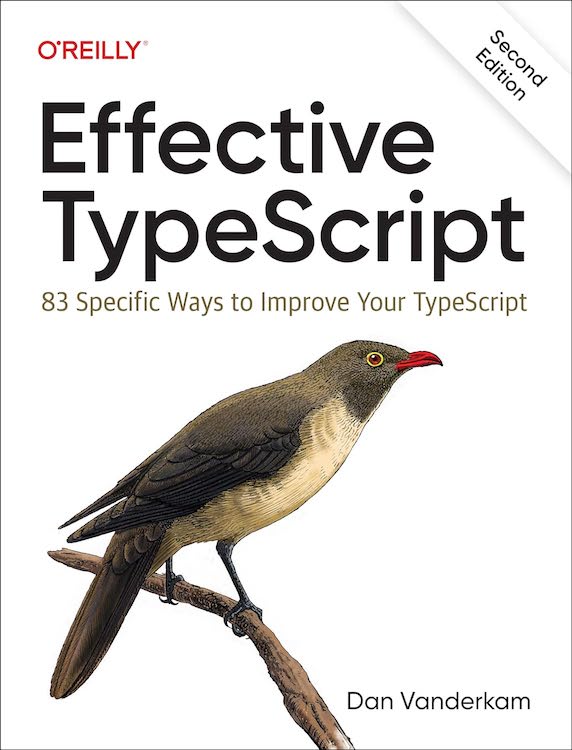Table of Contents
In an Effective-style book, the title of each item is a specific piece of advice. This means that the Table of Contents forms a summary of all the advice in the book. If any item piques your curiosity and you want to learn more, order a copy.
Chapter 1: Getting to Know TypeScript
Before we dive into the details, this chapter helps you understand the big picture of TypeScript. What is it and how should you think about it? How does it relate to JavaScript? Are its types nullable or are they not? What's this about any? And ducks?
- Understand the Relationship Between TypeScript and JavaScript
- Know Which TypeScript Options You're Using
- Understand That Code Generation Is Independent of Types
- Get Comfortable with Structural Typing
- Limit Use of the
any Type
Chapter 2: TypeScript’s Type System
This chapter walks you through the nuts and bolts of TypeScript's type system: how to think about it, how to use it, choices you'll need to make, and features you should avoid. TypeScript's type system is surprisingly powerful and able to express things you might not expect a type system to be able to. The items in this chapter will give you a solid foundation to build upon as you write TypeScript and read the rest of this book.
- Use Your Editor to Interrogate and Explore the Type System
- Think of Types as Sets of Values
- Know How to Tell Whether a Symbol Is in the Type Space or Value Space
- Prefer Type Annotations to Type Assertions
- Avoid Object Wrapper Types (String, Number, Boolean, Symbol, BigInt)
- Distinguish Excess Property Checking from Type Checking
- Apply Types to Entire Function Expressions When Possible
- Know the Differences Between
type and interface
- Use
readonly to Avoid Errors Associated with Mutation
- Use Type Operations and Generic Types to Avoid Repeating Yourself
- Prefer More Precise Alternatives to Index Signatures
- Avoid Numeric Index Signatures
Chapter 3: Type Inference
This chapter shows you some of the problems that can arise with type inference and how to fix them. After reading it, you should have a good understanding of how TypeScript infers types, when you still need to write type declarations, and when it's a good idea to write type declarations even when a type can be inferred.
- Avoid Cluttering Your Code with Inferable Types
- Use Different Variables for Different Types
- Understand How a Variable Gets Its Type
- Create Objects All at Once
- Understand Type Narrowing
- Be Consistent in Your Use of Aliases
- Understand How Context Is Used in Type Inference
- Understand Evolving Types
- Use Functional Constructs and Libraries to Help Types Flow
- Use
async Functions Instead of Callbacks to Improve Type Flow
- Use Classes and Currying to Create New Inference Sites
Chapter 4: Type Design
Code is difficult to understand if you can't see the data or data types on which it operates. This is one of the great advantages of a type system: by writing out types, you make them visible to readers of your code. And this makes your code understandable. Other chapters cover the nuts and bolts of TypeScript types: using them, inferring them, and writing declarations with them. This chapter discusses the design of the types themselves. The examples in this chapter are all written with TypeScript in mind, but most of the ideas are more broadly applicable.
- Prefer Types That Always Represent Valid States
- Be Liberal in What You Accept and Strict in What You Produce
- Don’t Repeat Type Information in Documentation
- Avoid Including
null or undefined in Type Aliases
- Push Null Values to the Perimeter of Your Types
- Prefer Unions of Interfaces to Interfaces with Unions
- Prefer More Precise Alternatives to String Types
- Use a Distinct Type for Special Values
- Limit the Use of Optional Properties
- Avoid Repeated Parameters of the Same Type
- Prefer Unifying Types to Modeling Differences
- Prefer Imprecise Types to Inaccurate Types
- Name Types Using the Language of Your Problem Domain
- Avoid Types Based on Anecdotal Data
Chapter 5: Unsoundness and the any Type
Type systems were traditionally binary affairs: either a language had a fully static type system or a fully dynamic one. TypeScript blurs the line, because its type system is optional and gradual. You can add types to parts of your program but not others. This is essential for migrating existing JavaScript codebases to TypeScript bit by bit. Key to this is the any type, which effectively disables type checking for parts of your code. It is both powerful and prone to abuse. Learning to use any wisely is essential for writing effective TypeScript. This chapter walks you through how to limit the downsides of any while still retaining its benefits.
- Use the Narrowest Possible Scope for
any Types
- Prefer More Precise Variants of
any to Plain any
- Hide Unsafe Type Assertions in Well-Typed Functions
- Use
unknown Instead of any for Values with an Unknown Type
- Prefer Type-Safe Approaches to Monkey Patching
- Avoid Soundness Traps
- Track Your Type Coverage to Prevent Regressions in Type Safety
Chapter 6: Generics and Type-Level Programming
TypeScript's type system is designed to model the runtime behavior of JavaScript code. Because JavaScript is so dynamic and permissive, this has pushed TypeScript's type system to develop increasingly powerful capabilities. This includes logic for mapping between types. When you add generic type aliases to the mix, TypeScript's type system becomes powerful enough that you can think of it as its own independent programming language. This chapter will help you decide whether it's necessary to use generic types and presents some alternatives. Used well, type-level code can improve other developers' experiences without their ever needing to know that there's fancy type-level code involved.
- Think of Generics as Functions Between Types
- Avoid Unnecessary Type Parameters
- Prefer Conditional Types to Overload Signatures
- Know How to Control the Distribution of Unions over Conditional Types
- Use Template Literal Types to Model DSLs and Relationships Between Strings
- Write Tests for Your Types
- Pay Attention to How Types Display
- Prefer Tail-Recursive Generic Types
- Consider Codegen as an Alternative to Complex Types
Chapter 7: TypeScript Recipes
As the TypeScript community has grown, developers have come up with more and more tricks for solving specific problems. Some of these "recipes" leverage TypeScript's type checker to catch new categories of mistakes, such as values getting out of sync or nonexhaustive conditionals. Others are tricks for modeling patterns that TypeScript struggles with on its own: iterating over objects, filtering null values from Arrays, or modeling variadic functions. By applying the recipes in this chapter, you'll help TypeScript catch more real problems with fewer false positives.
- Use
never Types to Perform Exhaustiveness Checking
- Know How to Iterate Over Objects
- Use
Record Types to Keep Values in Sync
- Use Rest Parameters and Tuple Types to Model Variadic Functions
- Use Optional
never Properties to Model Exclusive Or
- Consider Brands for Nominal Typing
Chapter 8: Type Declarations and @types
Dependency management can be confusing in any language, and TypeScript is no exception. This chapter will help you build a mental model for how dependencies work in TypeScript and show you how to work through some of the issues that can come up with them. It will also help you craft your own type declaration files to publish and share with others. By writing great type declarations, you can help not just your own project but the entire TypeScript community.
- Put TypeScript and
@types in devDependencies
- Understand the Three Versions Involved in Type Declarations
- Export All Types That Appear in Public APIs
- Use TSDoc for API Comments
- Provide a Type for
this in Callbacks if It's Part of Their API
- Mirror Types to Sever Dependencies
- Use Module Augmentation to Improve Types
Chapter 9: Writing and Running Your Code
This chapter is a bit of a grab bag: it covers some issues that come up in writing code (not types) as well as issues you may run into when you run your code.
- Prefer ECMAScript Features to TypeScript Features
- Use Source Maps to Debug TypeScript
- Know How to Reconstruct Types at Runtime
- Understand the DOM Hierarchy
- Create an Accurate Model of Your Environment
- Understand the Relationship Between Type Checking and Unit Testing
- Pay Attention to Compiler Performance
Chapter 10: Modernization and Migration
You've heard that TypeScript is great. You also know from painful experience that maintaining your 15-year-old, 100,000-line JavaScript library isn't. If only it could become a TypeScript library! This chapter offers some advice about migrating your JavaScript project to TypeScript without losing your sanity and abandoning the effort.
- Write Modern JavaScript
- Use
@ts-check and JSDoc to Experiment with TypeScript
- Use
allowJs to Mix TypeScript and JavaScript
- Convert Module by Module Up Your Dependency Graph
- Don't Consider Migration Complete Until You Enable
noImplicitAny

